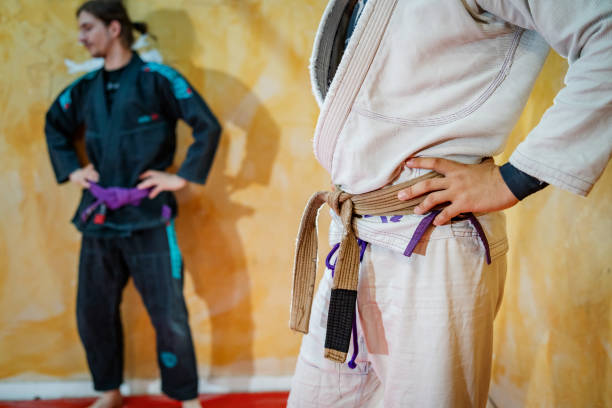MMA, a combat sport that involves full-contact, requires mastery of technique and allows athletes to employ their entire physique during combat. To excel in MMA, one must posses robust fitness and agility. This goal can be achieved using different MMA training techniques.
If you want to become a well-rounded fitness enthusiast, you need to start a workout program like an MMA fighter. MMA athletes are known for their extreme fitness levels and ability to adapt to new exercises and workouts quickly.
If you can mimic some of the principles these athletes use in their training, you’ll achieve the same fitness level.
Fighters practicing MMA are some of the fittest athletes on the planet. They’re fighting until they can’t fight anymore. They’re just willing to do whatever it takes in the MMA gym, on the road, and in the ring to win.
This article has some of the most useful tips to teach you the basics of MMA training and how to train like an MMA fighter for optimal fitness.

The Basics
Fighters train for hours on end to prepare for their next MMA fight. Here is a breakdown of what you need to know to get the most out of your training:
Martial Arts Combination
MMA fighting involves combining various disciplines, such as judo, boxing, Muay Thai, Brazilian Jiu-Jitsu, and wrestling. This means that MMA athletes must be versatile in all aspects of their skills.
Exercise Program
Fighters require high-intensity cardio workouts that burn many calories to improve body conditioning. Cardio can also help build muscle and reduce fat storage. Getting a conditioning coach also helps.
Stretching
In addition to working on their cardio, many MMA fighters include stretching exercises into their routine to keep them flexible and injury-free. Stretching improves flexibility and relieves stress and tension in the body.
Proper Technique
Martial artists also need to use the correct technique during their workouts. MMA is one of the popular full-combat sports today, and it is important to train in a way that allows them to stay safe while still improving their skills.

MMA Workout: A Breakdown of a Typical MMA Fighter’s Workout Routine
The Mixed Martial Arts fighters are in constant motion, which means their workout routine must also be constant. A typical MMA fighter’s workout routine includes cardiovascular exercise, weight training, resistance training, and conditioning work.
Cardiovascular exercise helps to improve heart health and endurance, while weight training helps build muscle mass and improve balance and coordination. Conditioning work is essential for MMA fighters because it helps them stay agile and fit while preparing for a fight. An MMA fighter’s workout routine may include the following exercises:
Punching Bag Workouts

The punching bag is a must gym equipment you should have when training in this type of martial arts. Using a punching bag as your resistance increases the intensity and caloric burn of your regular cardio routine. This will help tone your body, but it can also improve your balance, coordination, and reflexes. And if that’s not enough, add some light sparring to the mix for added muscle-building benefits. So what are you waiting for? Get punching!
Shadow Boxing

There is a lot of talk about “shadow boxing” these days. Some people swear by it to build endurance; others claim that it’s just another way to pump up the ego. But what is it? In short, shadow boxing is a form of exercise that involves quickly moving your fists in front of your body without landing any punches.
It’s also known as “bag punching” or “speed punching” and can be done with an empty or weighted bag. The goal is to keep your punches moving fast and loose so that you enter into the rhythm of the fight instead of thinking about each swing.
Shadowboxing can be done in the gym or outside. It’s great for building speed and stamina and improving overall coordination. Shadowboxing is also a great way to test new techniques against an opponent (a punching bag) without putting your real body at risk.
Shadowboxing is a great way to hone your skills and develop your overall understanding of striking mechanics.
The first step in shadowboxing is becoming aware of the weight shift. The second step is to shift the weight into being on your front foot. The third step in shadowboxing is shifting to a rearfoot and then back to the front. The final step is shifting to a side-foot stance and returning to the neutral.
Shadowboxing is a great way to test new techniques against an opponent (a punching bag). The key to shadowboxing training is mental visualization of what you want your outcome to be.
Shadowboxing can be used in conjunction with one-on-one drills. Only one person is striking at an opponent in a one-on-one drill, and the training partner must react to their strikes. This allows the training partner to get used to having someone hit them while they are in the middle of shadowboxing.
Shadowboxing is also used in various physical fitness exercises that include jumping jacks, push-ups, sit-ups, and other types of calisthenics.
The original purpose of shadowboxing was to condition the body for combat. The main goals of shadowboxing are to improve the ability to defend oneself against a real attack, develop an improved rhythm, and build up stamina. Shadowboxing can be used to warm up before exercise or as a way to stay in shape.
Kettlebell Training

Mixed martial arts (MMA) fighters are often in high-intensity, continuous action. This type of training requires strength and conditioning, cardiovascular fitness, and flexibility. Kettlebells have emerged as a popular tool for Mixed Martial Arts fighters looking to achieve their fitness goals.
Kettlebells are versatile tools that can be used for a variety of exercises. They can help you build strength, endurance, and cardio capacity. They are also a good way to increase your flexibility because they require you to use your entire body in different positions.
If you’re interested in incorporating kettlebell training into your MMA routine, start with basic exercises like the swing and the kettlebell push-up. As you become more comfortable with these exercises, you can move on to more challenging exercises like the Turkish get-up and the Russian twist.
Circuit Training

Athletes need to be in great cardiovascular shape if they want to stay in the cage fighting for very long. Circuit training can help with this by working the entire body. The following circuit is designed to be completed three times per week:
Warm-up
Run-on a treadmill or walk on a level surface for five minutes.
Cardio Workout
Perform 20-30 repetitions of a basic cardio exercise such as running, jogging, or walking at a moderate speed.
Strength Workout
Do two sets of 10 reps of an intense strength exercise such as squats, bench press, or lunges. Rest only 30 seconds between sets.
Cool-down
Stretch and foam roll followed by five minutes of relaxation exercises such as yoga or meditation.
After completing the circuit three times a week, your body will be ready to handle the challenges of today’s fast-paced and high-stress lifestyle. Cardio workouts performed at low intensity do not need as much recovery as intense workouts.
Weight Training

Mixed martial arts fighters need strong muscles and bones to compete. However, the focus on strength training in MMA is often geared towards Olympic weightlifting. While Olympic weightlifting is an excellent form of weight training, it’s not the only way to get the most out of your workout.
Here are six reasons you should add weightlifting to your MMA fitness routine:
- Help increase lean muscle mass and strength without adding body fat.
- An improve your balance, coordination, and reflexes.
- It can improve your cardiovascular fitness and endurance.
- It can help increase flexibility and range of motion.
- Help improve your posture, core stability, and shoulder health.
- Reduce stress, improve overall health, and reduce the risk of injury.
To be clear, weightlifting is not a substitute for other forms of strength training. Weightlifting is a skill and an art form in itself. It would be best to always combine your lifting with other forms of strength training to keep yourself from overtraining.
For example, if you are a weightlifter and you do the same routine for a long period, your body will adapt to it. It will become weaker, which is normal and expected. Your body will learn how to use the stress that weightlifting puts on it, and this is good for your fitness.
However, if you keep doing the same routine every time you work out, you will eventually lose muscle mass and strength. This is not good for you and will not give you the results you want. You need to switch things up every once and keep your body guessing. The best way to do this is to combine strength training with aerobic exercise, in my opinion.
Yoga

MMA fighters have long been known for their explosive strength, speed, and agility. However, many of these same athletes may be struggling to maintain their conditioning due to MMA competition’s rigorous training and physical demands. According to one study, 85% of an MMA fighter’s energy is expended during sparring sessions.
One way to improve conditioning and reduce the risk of injury is through yoga. Yoga has been shown to improve balance, flexibility, and muscular endurance. Additionally, it can help reduce anxiety and stress levels, impacting overall fitness levels.
For MMA fighters looking for a way to stay fit and healthy on the go, yoga may be a great option. Several yoga techniques can be utilized in MMA training, including:
- Downward Dog
- Cobra Pose
- Warrior I Pose
- Half Moon Pose
- Bridge Pose
- Child’s Pose
The Diet: What Fighters Eat to Stay in Top Shape
Training and competing can wary down fighters. To stay in top shape, they must eat a healthy diet. Here are some of the diets that martial artists typically follow:
Fighter’s Macro Fueled Diet: This diet consists of high-quality protein, carbohydrates, and healthy fats. It fuels muscles during workouts and helps maintain energy levels during long fights.
Gluten-Free Diet for Fighters: Many MMA fighters have gluten allergies or intolerances, making eating a traditional Western diet difficult or even impossible. A gluten-free diet is often prescribed to help alleviate any digestive problems caused by wheat and other grains.
Low-Carbohydrate/High-Protein Diet: This type of diet is popular with bodybuilders and athletes who want to maintain muscle mass while cutting down on body fat.
Paleo Diet: This diet is based on the idea that humans have not changed dramatically since the Stone Age. The diet consists of lean meats, fresh fruits, nuts, and seeds.
Whole-Food/Plant-Based Diet: This diet is most commonly associated with vegetarianism, but it can also be followed by those who want to lose weight or maintain a healthy body weight.
VLCD: This type of diet is usually used for weight loss. Dieters use a liquid formula that contains all the nutrients necessary for weight loss.
Liquid Diet: This diet is also known as a liquid meal replacement. It consists of a liquid formula containing all the necessary nutrients for weight loss.
Fasting: This is the practice of going without food or caloric intake.
Vegan Diet: A vegan diet excludes all animal-based foods.
Raw Food Diet: This diet is a raw food diet. This type of diet aims to consume as few processed foods as possible.
Pescatarian Diet: This type of diet is a vegetarian diet that includes fish.
Cleansing Diet: A cleansing diet cleans the body and provides an energy boost.

Supplements: What Supplements Fighters Use to Stay Healthy and Fit
Fighters, like any athletes, use a variety of supplements to help them stay healthy and fit. These supplements can include protein, vitamins, minerals, and herbs.
Some fighters also take supplements to help them recover from workouts and training sessions. MMA fighters often take supplements to help with recovery. Some of these recovery supplements include:
• Whey protein: This is a protein supplement that can be taken by athletes who work out regularly. It helps the muscles recover and repair themselves after training sessions and workouts.
• Creatine: This is a supplement that many athletes take to help them build muscle and strength. It also helps the muscles recover and repair themselves after training sessions.
• Glutamine: This is a supplement that can be taken by athletes who are working out regularly.
• BCAAs: These are a type of protein that can be taken by athletes who are working out and training regularly.
• Nitric Oxide: This supplement helps oxygen and nutrients reach the muscles more efficiently. It also helps muscles repair themselves after training sessions.
• Creatine Mono-Sodium Phosphate: This is a supplement that can be taken by athletes who are working out regularly.
• L-Arginine: This is a supplement that can be taken by athletes who are working out and training regularly.
• L-Glutamine: This is a supplement that can be taken by athletes who are working out and training regularly.
• Folic Acid: This supplement helps prevent damage to the blood vessels, so they do not become damaged while exercising.
• Zinc: This is a supplement that can be taken by athletes who are working out and training regularly.
• Vitamin D: This is a supplement that helps build muscles and bones and promotes the absorption of calcium from the body.
Final Thoughts
If you’re looking to get fit and improve your MMA skills, one of the best ways to do so is by training like an MMA fighter. By incorporating some of their training methods into your routine, you can not only improve your fitness levels but also develop the same discipline, strength, and cardio conditioning that these athletes possess.
There are a few key things to keep in mind when it comes to MMA training. First, be consistent. No matter how well you feel after training, always make sure to go back and do it again.
While MMA fighters may be able to knock out their opponents in a single round, their training methods are why they are still standing when the final bell rings.
It is important to be prepared for any kind of situation. Do not contain your training in an MMA gym; you can still train at home when needed.
It is also important to take your training seriously. You may not see yourself as an MMA fighter, but you are training like one. If you are not training as hard as you can, then you will never be able to perform at your best when the time comes.
Last but not least, it is important to have fun while you are training. It is easy to get wrapped up in the serious business of MMA training and forget about having fun. MMA fighters can perform amazing feats, but they also have a sense of humor, and a good sense of humor helps them stay positive during training.





